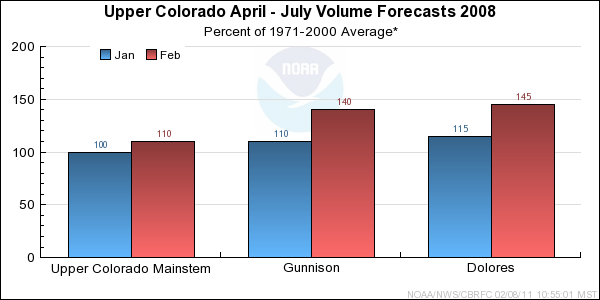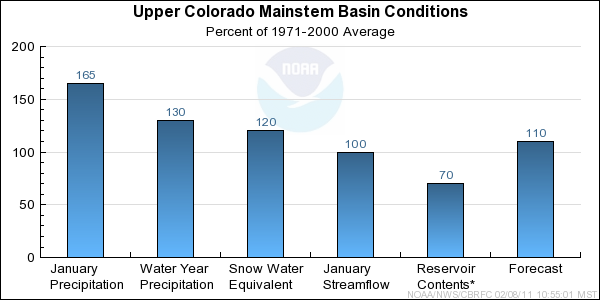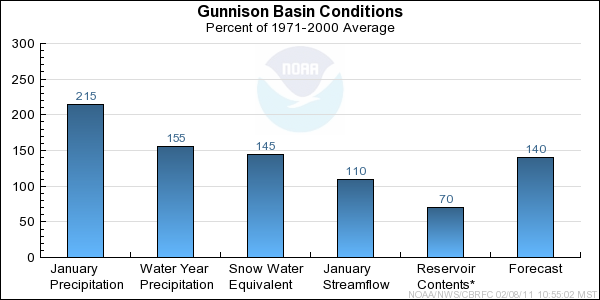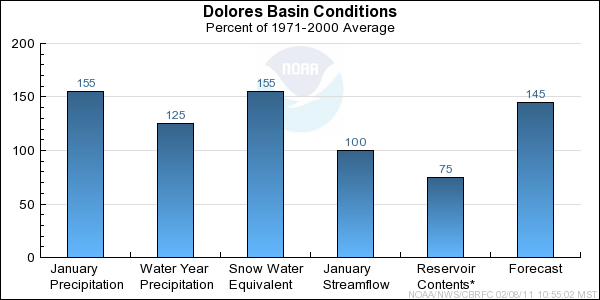Upper Colorado Water Supply Outlook, February 1, 2008
Note: This publication is scheduled for revision. If you have feedback on content, format, or publication frequency, please contact us.
Contents
Upper Colorado Summary
Although the January percent of average monthly precipitation was not quite as
high as December, it was still much above average across the Upper Colorado
Basin. As a result, the February 1 snow water equivalent percent of average
values rose 15% in the Upper Colorado mainstem and 30% in the Gunnison and
Dolores basins from the January 1 values. Forecasts of the April through July
runoff volumes rose 10% to 40% from those issued January 1.

*Median of forecasts within each basin.
Upper Colorado Mainstem Basin Conditions
January was another wet month in the Upper Colorado mainstem with 165% of the
basin average precipitation. This brought the seasonal precipitation to
130% of average and the snow water equivalent to 120% of average as of February
1st. However, the snowpack is not uniform across the basin. The Roaring Fork
and Plateau Creek basins represent the high end of the spectrum with close to
150% of average snow water equivalent, while the basins above Kremmling
generally have between 100% and 115% of average snow water equivalent. Because
of the great gains in the snowpack all forecasts increased from last month,
with the Roaring Fork and Plateau Creek points changing the most. The April
through July streamflow forecasts now range between 100% and 130% of average.

* Percent usable capacity, not percent average contents.
Click for multi-month Graph.
Gunnison Basin Conditions
Above average precipitation continued in the Gunnison Basin for the month of
January with the basin receiving 215% of the monthly average. The basin is now
at 155% of the seasonal average as of February 1st. All SNOTEL gages in the
basin are now above 70% of their average seasonal maximum snowpack accumulation.
Three SNOTELs, Overland Res. (127%), Park Cone (111%), and Columbine Pass (111%),
have already accumulated over 100% of their average seasonal maximum snowpack.
Even though precipitation was above normal for January, streamflow remains
around average since most precipitation fell as snow. April through July volume
forecasts have increased because of the above average snow fall. Volume
forecasts now range from 131% of average at Taylor Park Reservoir to 152% of
average at Paonia Reservoir.

* Percent usable capacity, not percent average contents.
Click for multi-month Graph.
Dolores Basin Conditions
Monthly precipitation in the Dolores Basin for January was above normal. The
precipitation total was not as impressive as December but still much above
average at 155% of the monthly average. Seasonal precipitation is now at 125%
as of February 1st. All SNOTEL gages in the Dolores are above 80% of their
average seasonal maximum snowpack accumulation. Scotch Creek (105%) and Lizard
Head Pass (105%) are already above 100% of their average seasonal maximum
snowpack accumulation. Even though precipitation was above normal for January,
streamflow remains around average since most precipitation fell as snow. April
through July volume forecasts have increased because of the above average snow
fall. Volume forecasts now range from 136% of average on the San Miguel River
at Placerville to 159% of average on the Dolores River at Cisco.

* Percent usable capacity, not percent average contents.
Click for multi-month Graph.
Differences between the full period forecasts and the residual forecasts may not exactly equal the actual observed volumes due to rounding conventions (see Definitions section).
Precipitation Maps


Hydrologist: Brenda Alcorn, John Lhotak







